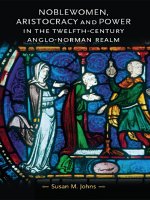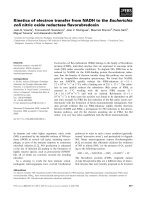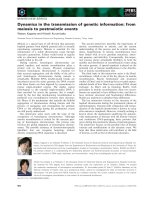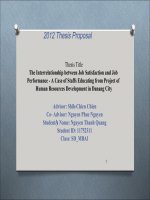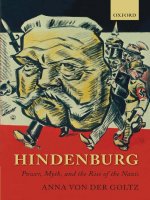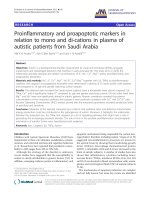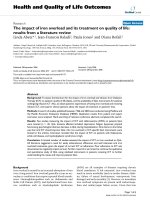- Trang chủ >>
- Khoa Học Tự Nhiên >>
- Vật lý
civil resistance and power politics the experience of non-violent action from gandhi to the present nov 2009
Bạn đang xem bản rút gọn của tài liệu. Xem và tải ngay bản đầy đủ của tài liệu tại đây (5.2 MB, 432 trang )
CIVIL RESISTANCE AND POWER POLITICS
This page intentionally left blank
Civil Resistance and
Power Politics
The Experience of Non-violent Action
from Gandhi to the Present
Edited by
ADAM ROBERTS
TIMOTHY GARTON ASH
1
3
Great Clarendon Street, Oxford ox2 6dp
Oxford University Press is a department of the University of Oxford.
It furthers the University’s objective of excellence in research, scholarship,
and education by publishing worldwide in
Oxford New York
Auckland Cape Town Dar es Salaam Hong Kong Karachi
Kuala Lumpur Madrid Melbourne Mexico City Nairobi
New Delhi Shanghai Taipei Toronto
With oYces in
Argentina Austria Brazil Chile Czech Republic France Greece
Guatemala Hungary Italy Japan Poland Portugal Singapore
South Korea Switzerland Thailand Turkey Ukraine Vietnam
Oxford is a registered trade mark of Oxford University Press
in the UK and in certain other countries
Published in the United States
by Oxford University Press Inc., New York
q The several contributors 2009
The moral rights of the authors have been asserted
Database right Oxford University Press (maker)
First published 2009
All rights reserved. No part of this publication may be reproduced,
stored in a retrieval system, or transmitted, in any form or by any means,
without the prior permission in writing of Oxford University Press,
or as expressly permitted by law, or under terms agreed with the appropriate
reprographics rights organization. Enquiries concerning reproduction
outside the scope of the above should be sent to the Rights Department,
Oxford University Press, at the address above
You must not circulate this book in any other binding or cover
and you must impose the same condition on any acquirer
British Library Cataloguing in Publication Data
Data available
Library of Congress Cataloging in Publication Data
Data available
Typeset by SPI Publisher Services, Pondicherry, India
Printed in Great Britain
on acid-free paper by
CPI Antony Rowe, Chippenham, Wiltshire
ISBN 978–0–19–955201–6
13579108642
Preface
Civil resistance has become an increasingly salient feature of international politics
over the last half-century, from the US civil rights movement and Czechoslovakia
in the 1960s to the so-called ‘colour revolutions’ in eastern Europe and Burma’s
‘moment of the monks’ in the 2000s. We believe that the phenomenon of non-
violent action deserves more study than it has so far received, and that it should
be examined in a broader comparative context of international relations, politics,
and contemporary history.
At the heart of this book are nineteen case studies of major historical episodes
in which civ il resistance played an important part. Each chapter is the work of an
individual author, with his or her own distinctive approach, style and special
interests. Bibliographical references and all but the most familiar abbreviations
have been spelt out at Wrst mention in every chapter, so that each can be read on
its own. We have, however, gone to considerable lengths, both in the original
design and in the detailed editing of this book, to try to ensure a common
intellectual agenda. Carefully chosen documentary photographs are reproduced
at appropriate points in each chapter. Extended captions, written by the editors in
close consultation with individual authors, both explain the particular circum-
stances and highlight the illustrations’ relevance to larger themes.
This is the Wrst major publication of the Oxford University Project on Civil
Resistance and Power Politics. We print below a list of seventeen questions
addressed to contributors at the start of the project. Of course not all are relevant
to or can be answered in each case, and others have emerged as research has
progressed. These questions exemplify the project’s concern to explore, rigorously
and sceptically, the historical roles played by civil resistance, and to clarify the
relationship between civil resistance and other elem ents of power. That relation-
ship turns out to be more multifaceted than many proponents of civil resistance,
or indeed of power politics, might have expected. Some of these connections are
further teased out in the editors’ introductory and concluding chapters.
A.R., T.G.A.
Oxford,
March 2009
Acknowledgements
First and foremost we thank all our colleagues on the Oxford University project
on ‘Civil Resistance and Power Politics: Domestic and International Dimensions’,
which was established in 2006. The project held an international conference at
Oxford on 15–18 March 2007. This w as attended not only by academi c experts on
particular cases of civil resistance, but also by participants in the campaigns,
journalists and writers who had reported on them, and oYcials who had in one
way or another been involved in responding to them.
Our deepest thanks go to Dr Thomas Richard Davies, who served from January
2006 to March 2008 as Research Associate of the project, and whose contributions
to the project, from the March 2006 workshop to the March 2007 conference, and
then to this book, were all outstanding. Without his work, which combined
eYciency, deep understanding, and helpfulness toward all involved in this enter-
prise, we could not have reached the Wnishing tape of publication so soon.
We also owe a special debt of gratitude to our fellow members of the project’s
Organizing Committee, Judith Brown, Peter Carey, Rana Mitter, Alex Pravda, and
Jan Zielonka, all of whom played a central role in guiding the project as a whole,
selecting contributors, and subsequently helping to edit the chapters in this
volume.
We are indebted to Sir Martin Gilbert for preparing the endpaper map. In the
search for photographs we had talented assistance from Daniel Hemel at Oxford
University, and from Steve York and Ragan Carpenter of York Zimmerman Inc.,
Washington, DC. While every eVort was made to contact the copyright holders of
material in this book, in some cases we were unable to do so. If the copyright
holders contact the author or publisher, we will be pleased to rectify any omission
at the earliest opportunity.
Ensuring that chapters in a wide-ranging book such as this have elements of
common structure and style, and are clear to non-specialists, is no simple task.
We are grateful to Kate Upshon for some exceptionally judicious subediting; to
Małgorzata Gorska for invaluable assistance in commenting on and revising
several chapters; to Mary-Jane Fox for rigorous comments on the Introduction
and the project as a whole; and, at Oxford University Press, to our editor,
Dominic Byatt, to members of the editorial staV, especially Lizzy SuZing, Louise
Sprake, and Aimee Wright; and to the copy-editor, Tom Chandler.
Most of the chapters are based on papers presented at the March 2007
conference, which were always intended for publication. In this volume we have
included revised texts of those papers that dealt with particular cases rather than
with more general or abstrac t themes, and we have added a new chapter, on the
events in Burma in 2007. We have also included three chapters (the Wrst two and
the last) exploring how civil resistance and power politics interact, and situating
the themes pursued in this volume in the context of other literature on civil
resistance and political change.
The chapters have been greatly enriched by the comments and reXections of the
participants in the conference, and we would especially like to thank for their
contributions the other conference speakers: Peter Ackerman, Alan Angell, Wil-
liam Beinart, Kenneth BloomWeld, Stephen Boswor th, Richard Caplan, Martin
Ceadel, Paul Chaisty, Thomas Richard Davies, Mient Jan Faber, James Fenton,
Lars Frede
´
n, Carlos Gaspar, David Goldey, Adrian Guelke, Hydajet Hyseni,
Mkhuseli Jack, Konrad Jarausch, Mary Kaldor, Mary King, Monika Mac-
Donagh-Pajerova
´
, Michael McFaul, Abbas Milani, Grazina Miniotaite, Edward
Mortimer, Ghia Nodia, Lucy Nusseibeh, Bhikhu Parekh, Chris Patten, Minxin Pei,
Frank Pieke, Srdja Popovic
´
, Dmytro Potekhin, Bob Purdie, Janusz Reykowski,
Berel Rodal, Zita Seabra, Jacques Semelin, Gene Sharp, Patricio Silva, Jonathan
Steele, Ed de la Torre, Samuel Valenzuela, Wang Juntao, David Washbrook,
Laurence Whitehead, Harris WoVord, Steve York, and Zarni. For the smooth
running of the conference, we are especially grateful to Denise Line of the
European Studies Centre, and to Emily Speers Mears and Małgorzata Gorska,
the graduate student assi stants. For their participation in the preparatory work-
shop for the conference, we would like to thank Arshin Adib-Moghaddam, Cath
Collins, Richard Crampton, Michael Freeden, Alan Knight, Teresa Pinto Coelho,
William Smith, Marc Stears, and Sherrill Stroschein.
The project on Civil Resistance and Power Politics is run under the auspices of
the Centre for International Studies in Oxford University’s Department of Pol-
itics and International Relations and the European Studies Centre at St Antony’s
College, Oxford: we are very grateful for the support of the Directors of these
institutions, Andrew Hurrell, Neil MacFarlane, and Kalypso Nicolaı
¨
dis. We also
owe special thanks to Esther Byrom for her handling of numerous research
funding applications.
Without the support of a number of generous funders, this book would not
have been possible. We would like to thank particularly: Peter Ackerman and
Berel Rodal at the International Center on Nonviolent ConXict in Washington,
DC; Judy Barsalou, April Hall, Steve Riskin, and Trish Thomson at the United
States Institute of Peace; Markus Baumanns and Michael Go
¨
ring at the Zeit
Foundation; Kristian Netland at the Norwegian Ministry of Foreign AVairs;
Stephen Heintz and Hope Lyons at the Rockefeller Brothers Fund; Maciek
Hawrylak and JeV Senior at the Canadian Department of Foreign AVairs and
International Trade; Joan Link and Matthew Preston at the British Foreign and
Commonwealth OYce; and the Research Grants staV of the British Academy.
Acknowledgements vii
This page intentionally left blank
Contents
List of Illustrations xi
List of Contributors xvi
List of Initial Questions xx
1. Introduction 1
Adam Roberts
2. People Power and Protest: The Literature on Civ il Resistance
in Historical Context 25
April Carter
3. Gandhi and Civil Resistance in India, 1917–47: Key Issues 43
Judith M. Brown
4. The US Civil Rights Movement: Power from Below and
Above, 1945–70 58
Doug McAdam
5. The Interplay of Non-violent and Violent Action in
Northern Ireland, 1967–72 75
Richard English
6. The Dialectics of Empire: Soviet Leaders and the Challenge
of Civil Resistance in East-Central Europe, 1968–91 91
Mark Kramer
7. Civil Resistance in Czechoslovakia: From Soviet Invasion to
‘Velvet Revolution’, 1968–89 110
Kieran Williams
8. Towards ‘Self-limiting Revolution’: Poland, 1970–89 127
Aleksander Smolar
9. Portugal: ‘The Revolution of the Carnations’, 1974–75 144
Kenneth Maxwell
10. Mass Protests in the Iranian Revolution, 1977–79 162
Ervand Abrahamian
11. ‘People Power’ in the Philippines, 1983–86 179
Amado Mendoza Jr
12. Political Mass Mobilization against Authoritarian Rule:
Pinochet’s Chile, 1983–88 197
Carlos Huneeus
13. The Interplay of Non-violent and Violent Action in the
Movement against Apartheid in South Africa, 1983–94 213
Tom Lodge
14. The Intersection of Ethnic Nationalism and People
Power Tactics in the Baltic States, 1987–91 231
Mark R. Beissinger
15. The 1989 Demonstrations in Tiananmen Square and Beyond:
Echoes of Gandhi 247
Merle Goldman
16. Civil Resistance and Civil Society: Lessons from the Collapse
of the German Democratic Republic in 1989 260
Charles S. Maier
17. The Limits of Prudence: Civil Resistance in Kosovo, 1990–98 277
Howard Clark
18. Civil Society versus Slobodan Milos
ˇ
evic
´
: Serbia, 199 1–2000 295
Ivan Vejvoda
19. Georgia’s ‘Rose Revolution’ of 2003: Enforcing Peaceful Change 317
Stephen Jones
20. Ukraine’s ‘Orange Revolution’ of 2004: The Paradoxes of Negotiation 335
Andrew Wilson
21. The Moment of the Monks: Burma, 2007 354
Christina Fink
22. A Century of Civil Resistance: Some Lessons and Questions 371
Timothy Garton Ash
Index 393
x Contents
Illustrations
1.1 Prague, August 1968: a woman remonstrates with invading Warsaw
Pact troops 11
1.2 US government provides armed protection of non violent civil rights
demonstrators. Montgomery, Alabama, March 1965 15
1.3 Vietnamese Buddhist monks at Xa Loi Pagoda in Saigon
on 18 August 1963 17
1.4 On 24 March 1999 President Clinton announces the start of
aerial bombing of Serbian targets 19
2.1 Playwright and impresario of civil resistance, Va
´
clav Havel, at the launch
of his new play in 2007 32
2.2 Burmese pro democracy campaigner Aung San Suu Kyi 35
2.3 In Kathmandu, capital of Nepal, tens of thousands celebrate the
ending of the period of royal rule and martial law, 27 April 2006 41
3.1 Gandhi and Jawaharlal Nehru, 6 July 1946 48
3.2 Gandhi on the salt march, 1930 52
3.3 Gandhi and Lord Mountbatten, 1947 55
4.1 Police dogs and water cannons used against peaceful civil rights
demonstrators in Birmingham, Alabama, 1963 69
4.2 Martin Luther King with US Attorney General Robert
F. Kennedy, Roy Wilkins of the NAACP and US Vice President
Lyndon B. Johnson outside the White House, 22 June 1963 71
4.3 Martin Luther King at the huge March in Washington, during
which he gave his ‘I have a dream’ speech, 28 August 1963 73
5.1 Civil rights march in the Catholic Falls Road area of Belfast,
July 1970, three months after the Wrst major confrontation
between Catholics and British soldiers in Belfast 78
5.2 Bernadette Devlin, a key Wgure in the civil rights movement
in Northern Ireland, April 1969 80
5.3 Two children in the predominantly Catholic Markets area of Belfast
re enact the shooting of four men the day before, August 1971 84
6.1 Alexander Dubc
ˇ
ek, First Secretary of the Czechoslovak communist
party, at a meeting in Bratislava of the leaders of six communist
states, 3 August 1968 92
6.2 Newly appointed leader of the Soviet communist party, Mikhail
Gorbachev, and Erich Honecker, the long time leader of East Germany’s
communist party, at its 11th party congress in East Berlin in April 1986 101
6.3 Boris Yeltsin reads a statement from atop a tank in Moscow,
19 August 1991, as he urges people to resist the attempted
coup d’e
´
tat 108
7.1 A road sign broken by Czechoslovak citizens to prevent the
invading Warsaw Pact forces from Wnding their way,
late August 1968 113
7.2 Wenceslas Square, in the centre of Prague, is deserted as a
one hour general strike begins at midday on 22 August 1968 118
7.3 Josef Smrkovsky, President of the Czechoslovak Parliament,
explains the results of Moscow negotiations to MPs during
an informal meeting in Prague, 27 August 1968 123
7.4 A vast crowd in Wenceslas Square, Prague, during a two hour
general strike on 27 November 1989 124
8.1 Vast crowds turn out to listen to the Polish Pope, John Paul II,
on his extraordinary pilgrimage to his native land in June 1979 130
8.2 Strike leader Lech Wałe˛sa waits to make his confession to a
Catholic priest during the historic strike in the Lenin shipyard
in Gdan
´
sk, August 1980 135
8.3 Prime Minister and army general Wojciech Jaruzelski and
Solidarity leader Lech Wałe˛sa, March 1981 137
8.4 The large round table ready for the televised formal opening
of the ‘round table negotiations’ pioneered by Poland from
February to April 1989 141
9.1 Huge crowds Wll the streets of Lisbon in celebration of the
young military oYcers who had overthrown one of Europe’s
longest lasting dictatorships in a coup d’e
´
tat on 25 April 1974 145
9.2 Dealing with the secret police, Portugal, late April 1974 148
9.3 Portuguese soldiers read a newspaper in late April 1974 to Wnd
out the latest on the ‘Revolution of the Carnations’ 155
10.1 A crowd estimated at one million marches through the streets
of Tehran in January 1979, demanding the return from exile
of Ayatollah Khomeini 164
10.2 Iranian women show support for Ayatollah Khomeini at
Tehran University, two days after his triumphal return
to Iran on 1 February 1979 167
10.3 US President Jimmy Carter on a brief visit to Tehran,
31 December 1977 175
11.1 Filipino opposition leader Benigno Aquino Jr lies dead on
the tarmac at Manila Airport, 21 August 1983 180
11.2 Cory Aquino, widow of Benigno, campaigning on
21 January 1986 for the presidential election held on 7 February 183
11.3 Demonstrators gather around eYgies of Philippine President
Ferdinand Marcos and US President Ronald Reagan, 3 February 1986 187
xii Illustrations
11.4 A Filipino youth slashes an oil painting of Philippine dictator
Ferdinand Marcos with a stick, February 1986 193
12.1 A riot policeman Wres tear gas at demonstrators in Santiago,
Chile, 18 November 1983 203
12.2 Chilean dictator General Pinochet welcomes US Secretary
of State Henr y Kissinger on a visit to Santiago, 8 June 1976 208
12.3 Demonstrators in Santiago celebrate Pinochet’s defeat in the
plebiscite held on the previous day, 5 October 1988 211
13.1 At a funeral on 7 September 1985 members of the
UDF aligned United Women’s Organization serve as a guard of honour 217
13.2 At a Cape Town funeral on 1 July 1985, Bishop Desmond
Tutu pleads with the crowd to spare the life of a suspected
police informant 219
13.3 South Africans at a funeral on 7 September 1985 for nine
people who had died during riots in Guguletu, a black
township in Cape Town 224
13.4 Frederik Willem de Klerk, the former South African president,
shaking hands with his successor, President Nelson Mandela,
in January 1994 226
14.1 At the ‘Baltic Chain’ demonstration on 23 August 1989,
placards symbolizing the Molotov Ribbentrop Pact are
burned in Tallinn, capital of Estonia 233
14.2 Inhabitants of Tallinn hold hands as part of the
‘Baltic Chain’ demonstration on 23 August 1989 236
14.3 The parliament building in Vilnius, the Lithuanian capital,
is protected by concrete and barbed w ire barricades, 18 January 1991 238
15.1 A student in Beijing’s Tiananmen Square wears the US civil
rights movement’s classic slogan, ‘We Shall Overcome’,
13 May 1989 252
15.2 A lone demonstrator seeks to block the path of a tank
convoy leaving Tiananmen Square in Beijing, 5 June 1989 255
16.1 After prayers for peace at St Nicholas’s Church in Leipzig,
demonstrators calling for peaceful change inside the
German Democratic Republic march around the city’s
inner ring road, October 1989 262
16.2 Soviet leader Mikhail Gorbachev embraces Erich Honecker,
East German communist leader, during the celebration of
the fortieth anniversary of the GDR’s creation, East Berlin,
7 October 1989 271
16.3 East Germans queue up to pass through the Wall to West Berlin,
10 November 1989 275
17.1 Ethnic Albanian students hold banners saying
‘Kosova university now tomorrow will be late’ in Kosovo’s
capital, Prishtina, 29 October 1997 283
Illustrations xiii
17.2 Serbian police beat ethnic Albanians during demonstrations
in Prishtina, 2 March 1998 285
17.3 Ibrahim Rugova, long time leader of Kosovar Albanians’
civil resistance, meets UN Secretary General KoW Annan
on 1 June 1998, at UN headquarters in New York 288
18.1 Serbian students marching in Belgrade face the police
cordon on Knez Mihajlova Street, 27 December 1996 301
18.2 ‘He’s Wnished!’ Slogan being stuck on a policeman’s
riot shield outside the Belgrade parliament, 5 October 2000 309
18.3 Bulldozer in front of the Yugoslav Federal parliament building
in Belgrade on 5 October 2000, the day the building was
occupied and Slobodan Milos
ˇ
evic
´
compelled to resign 313
18.4 A demonstrator waves a banner bearing the face of
opposition leader Vojislav Kos
ˇ
tunica on the steps of
parliament in Belgrade, 5 October 2000 315
19.1 Interior ministry servicemen greet opposition leaders in
the parliament yard in the Georgian capital Tbilisi,
23 November 2003 319
19.2 Georgian opposition supporters wave national Xags as they
stand on an armoured vehicle, celebrating the resignation
of President Eduard Shevardnadze, 23 November 2003 328
19.3 Georgian opposition leader Mikheil Saakashvili after a
meeting with President Eduard Shevardnadze in the
president’s residence, 23 November 2003 333
20.1 Thousands of orange balloons cover supporters of Ukraine’s
opposition presidential candidate Viktor Yushchenko
during a rally in Kiev’s Maidan square, 2 December 2004 336
20.2 Millionairess and politician Yuliia Tymoshenko, talking at
a press conference in Kiev, 26 December 2004 344
20.3 The round table at which Ukraine’s two rival presidential
candidates met on 26 November 2004, for the Wrst time
since a disputed vote 350
21.1 A protest by some 20,000 Buddhist monks and citizens in Rangoon,
23 September 2007 357
21.2 Supporters of the Buddhist monks march down a street
in Rangoon, 25 September 2007 359
21.3 UN Special Envoy Ibrahim Gambari poses with Myanmar’s
generals, 2 October 2007 364
22.1 Buddhist nuns taking part in a procession in Rangoon
on 25 September 2007 373
22.2 The vast turnout to welcome Ayatollah Khomeini to Tehran
on his return from exile, 1 Februar y 1979 378
xiv Illustrations
22.3 Mohandas Gandhi as a young man, before he became the ‘Mahatma’ 381
22.4 Va
´
clav Havel and Alexander Dubc
ˇ
ek toast the resignation of the
ruling politburo on the stage of the Magic Lantern theatre in Prague,
headquarters of the Velvet Revolution, 24 November 1989 383
The endpaper map was prepared by Sir Martin Gilbert
Illustrations xv
Contributors
Ervand Abrahamian is Distinguished Professor of History at City University of
New York. He is the author of Iran Between Two Revolutions (Princeton University
Press, 1982); The Iranian Mojahedin (Yale University Press, 1986); Khomeinism:
Essays on the Islamic Republic (University of California Press, 1993); Tortured
Confessions: Prisons and Public Recantations in Modern Iran (University of Cali-
fornia Press, 1999); and A History of Modern Iran (Cambridge University Press,
2008).
Mark R. Beissinger is Professor of Politics at Princeton University, specializing in
Russian and post-Soviet politics. He has written extensively on issues of national
identity and nationalist movements in the post-Soviet region. His works incl ude
Nationalist Mobilization and the Collapse of the Soviet State (Cambridge Univer-
sity Press, 2002) and The Nationalities Factor in Soviet Politics and Society (West-
view, 1990).
Judith M. Brown is Beit Professor of Commonwealth History at Oxford Univer-
sity and Professorial Fellow of Balliol College, Oxford. She is the author of
Gandhi’s Rise to Power: Indian Politics 1915–1922 (Cambridge University Press,
1972); Gandhi and Civil Disobedience. The Mahatma in Indian Politics 1928–34
(Cambridge University Press, 1977); Modern India: The Origins of an Asian
Democracy (Oxford University Press, 1984); Gandhi: Prisoner of Hope (Yale
University Press, 1989); Nehru: A Political Life (Oxford University Press, 2003);
and The Essential Writings of Mahatma Gandhi (Oxford University Press, 2008).
April Carter is an Honorary Research Fellow at the Centre for Peace and
Reconciliation Studies, Coventry University. Her most recent books are: The
Political Theory of Global Citizenship (Routledge, 2001) and Direct Action and
Democracy Today (Polity, 2005). She also compiled (with Howard Clark and
Michael Randle) People Power and Protest Since 1945: A Bibliography of Nonviolent
Action (Housmans Bookshop, 2006).
Howard Clark is Chair of War Resisters’ International and Visiting Research
Fellow at the Centre for Peace and Reconciliation Studies at Coventry University.
He is the author of Preparing for Nonviolent Direct Action (CND Publications,
1984) and Civil Resistance in Kosovo (Pluto, 2000). He compiled (with April
Carter and Michael Randle) People Power and Protest since 1945: A Bibliography
of Nonviolent Action (Housmans Bookshop, 2006) and edited People Power:
Unarmed Resistance and Global Solidarity (Pluto, 2009).
Richard En glish is Professor of Politics at Queen’s University. His publications
include History of Ireland (Gill and Macmillan, 1991); Armed Struggle: The
History of the IRA (Macmillan, 2003 ), which won the 2003 UK Political Studies
Association Politics Book of the Year Award; and Irish Freedom: The History of
Nationalism in Ireland (Pan, 2007), which won the 2007 Christopher Ewart-Big gs
Memorial Prize and the 2007 Political Studies Association of Ireland Book Prize.
Christina Fink is a Lecturer at the International Sustainable Development Studies
Institute in Chiang Mai, Thailand. She obtai ned her Ph.D. in social/cultural
anthropology from UC Berkeley in 1994. She wrote Living Silence: Burma
Under Military Rule (Zed Books, 2001) and co-edited Converging Interests:
Traders, Travelers, and Tourists in Southeast Asia (University of Cali fornia at
Berkeley, 1999).
Timothy Garton Ash is Professor of European Studies at the University of
Oxford, Isaiah Berlin Professorial Fellow at St Antony’s College, Oxford, and a
Senior Fellow at the Hoover Institution, Stanford University. As a ‘historian of the
present’ he witnessed a num ber of the episodes of civil resistance discussed in this
volume. His books include The Polish Revolution: Solidarity (3rd edn., Yale
University Press, 2002); The Magic Lantern: The Revolutions of ’89 Witnessed in
Warsaw, Budapest, Berlin and Prague (3rd edn., with a new Afterword, Vintage,
1999); In Europe’s Name (Jonathan Cape, 1993); History of the Present (Penguin,
2000); Free World (Penguin, 2004); and Facts are Subversive (Atlantic Books,
2009).
Merle Goldman is Professor Emerita at Boston University and Associate at the
Fairbank Center for Chinese Studies, Harvard University. She is the author of
several books, including Literary Dissent in Communist China (Harvard Univer-
sity Press, 1967); China’s Intellectuals: Advise and Dissent (Harvard University
Press, 1981); Sowing the Seeds of Democracy in China: Political Reform in the Deng
Xiaoping Decade (Harv ard University Press, 1994); and From Comrade to Citizen:
The Struggle for Political Rights in China (Harvard University Press, 2005).
Carlos Huneeus is Professor of the Institute of International Studies at the
University of Chile and Executive Director of Corporation CERC. His publica-
tions include: Chile, un paı
´
s dividido: la actualidad del pasado (Catalonia Ltda.,
2003); El re
´
gimen de Pinochet (Editorial Sudamericana, 2000); Los chilenos y la
polı
´
tica: cambio y continuidad bajo el autoritarismo (ICHEH, 1987); Para vivir la
democracia: dilemas de su consolidacio
´
n (Editorial Andante, 1987); and Los cami-
nos a la democracia: los casos de Argentina, Espan
˜
a, Grecia y Portugal (Ediciones
Aconcagua, 1978).
Stephen Jones is Professor of Russian and Eurasian Studies at Mount Holyoke
College. He has written over fift y articles and chapters on Georgian history and
politics. His books include Third World Countertrade: Analysis of 1,350 Deals
Involving Developing Countries, 1980–1987 (Produce Studies, 1988); Socialism in
Georgian Colors: the European Road to Social Democracy, 1883–1917 (Harvard
University Press, 2002); and Georgia: A Political Life: 1985–2007 (I. B. Tauris,
forthcoming 2009).
Contributors xvii
Mark Kramer is Director of the Harvard Cold War Studies Project at Harvard
University and a Senior Fellow at Harvard’s Davis Center for Russian and
Eurasian Studies. Professor Kramer is the editor of the Journal of Cold War
Studies, published by MIT Press four times a year, and of the Harvard Cold
War Studies Book Series, published by Rowman & LittleWeld.
Tom Lodge is Professor of Peace and ConXict Studies at the University of
Limerick. He has considerable personal experience of life and politics in South
Africa in the last years of apartheid, having been a member of the Department of
Political Studies at the University of Witwatersrand between 1978 and 2005. He is
the author of Black Politics in South Africa since 1945 (Ravan Press, 1983) and
Mandela: A Critical Life (Oxford University Press, 2006).
Doug McAdam is Professor of Sociolog y at Stanford University. He is the author
or co-author of eight books and more than sixty articles in the area of political
sociology, with a special emphasis on the study of social movements and revolu-
tions. His works include Political Process and the Development of Black Insurgency,
1930–1970 (University of Chicago Press, 1982); Freedom Summer (Oxford
University Press, 1988); and Dynami cs of Contention (Cambridge University
Press, 2001 ).
Charles S. Maier is the Leverett Saltonstall Professor of History at Harvard
University where he teaches European and international history. His most recent
books include The Cold War in Europe: Era of a Divided Continent (Markus
Wiener, 1996); Dissolution: The Crisi s of Communism and the End of East
Germany (Princeton University Press, 1997); and Among Empires: American
Ascendancy and its Predecessors (Harvard University Press, 2006).
Kenneth Maxwell is Director of the Brazil Studies Program at Harvard Univer-
sity’s David Rockefeller Center for Latin American Studies and a Visiting Profes-
sor in the Department of History. His publications include: ConXicts and
Conspiracies: Brazil and Portugal 1750–1808 (Cambridge University Press,
1973); The Making of Portuguese Democracy (Cambridge University Press,
1995); and The New Spain: From Isolation to InXuence (Council on Foreign
Relations Press, 1994). He is a regular contributor to the New York Review of
Books, World Policy Journal, and Folha de Sa
˜
o Paulo.
Amado Mendoza Jr is Associate Professor in Political Science and International
Studies at the University of the Philippines in Diliman, Qu ezon City. He has
edited two books, Debts of Dishonor (Philippine Rural Reconstruction Move-
ment, 1991) and From Crisis to Crisis: A Historical Analysis of the Recurrent
Balance of Payments Crisis in the Philippines (National Economic Protectionism
Association, 1987). He has written many articles on Philippine politics and
economics.
Adam Roberts is President of the British Academy; Emeritus Professor of Inter-
national Relations, Oxford University; and Emeritus Fellow of Balliol College,
Oxford. His books include: as editor, The St rategy of Civ ilian Defence: Non-violent
xviii Contributors
Resistance to Aggression (Faber, 1967); with Philip Windsor, Czechoslo vakia 1968:
Reform, Repression and Resistance (Chatto & Windus, 1969); Nations in Arms: The
Theor y and Practice of Territorial Defence (Chatto & Windus, 1976); and as joint
editor, The United Nations Security Council and War: The Evolution of Thought
and Practice since 1945 (Oxford University Press, 2008).
Aleksander Smolar is Chairman of the Board of the Stefan Batory Foundation in
Warsaw and a Senior Research Fellow at the Centre National de la Recherche
ScientiWque in Paris. His publications include, as editor: La Grande Secousse:
Europe de l’Est 1989–1990 (CNRS, 1990); Globalization, Power, and Democracy
(Johns Hopkins University Press, 2000); and De Kant a
`
Kosovo (Presses de
Sciences Po, 2003).
Ivan Vejvoda is Executive Director of the Balkan Trust for Democracy. He has
edited several books including Yugoslavia and After: A Study in Fragmentation,
Despair and Rebirth (Longman, 1996) and Democratization in Central and Eastern
Europe (Continuum, 2002).
Kieran Williams is Instructor in Politics at Drake University. His publications
include: The Prague Spr ing and its Aftermath: Czechoslovak Politics, 1968–1970
(Cambridge University Press, 1997); Security Intelligence Services in New Democ-
racies: The Czech Republic, Slovakia and Romania (Palgrave, 2001); and Slovakia
after Communism and Mec
ˇ
iarism (University College, School of Slavonic and East
European Studies, 200 0).
Andrew Wilson is Senior Lecturer in Ukrainian Studies at the School of Slavonic
and East European Studies at the University College London. His recent publi-
cations include Ukraine’s Orange Revolution (Yale University Press, 2005) and
Virtual Politics: Faking Democracy in the Post-Soviet World (Yale University Press,
2005).
Contributors xix
Initial Questions
1. Were the reasons for the use of non-violent methods derived from an
absolute rejection of all political violence, or from more particular
strategic, moral, cultural, and other considerations?
2. To the extent that a non-violent movement was able to operate eVectively,
was this in part due to particular favourable circumstances in the overall
power situation, both domestic and international? How important are
methods of civil resistance as opposed to the conditions within which it
operates?
3. Has civil resistance demonstrated a particular value as one instrument
(alongside other instruments such as external election monitors) for
challenging fraudulent election processes and ensuring a free and fair
outcome?
4. Can an international legal/normative regime provide a favourable
background for civil resistance?
5. To what extent did the non-v iolent movement succeed in undermining, or
threatening to undermine, the adversary’s sources of power and legitimacy
(military, economic, psychological, organizational, etc.)?
6. Was any force or violence used alongside non-violent methods, and if so
what were its eVects?
7. What has been the role of external actors of all kinds (government, quasi-
non-governmental organizations, NGOs, diasporas) in assisting or
attempting to inXuence civil resistance?
8. Is there evidence of agents provocateurs being sent in by the state, or of
other eVorts to discredit the movement by depicting it as violent?
9. How has the development of technologies, especially information technology
(e.g. fax, email, internet), aVected the capacities of civil resistance?
10. Was there any implicit or explicit threat of a future use of force or violence
to carry forward the non-violent movement’s cause if the movement did
not achieve a degree of success, or if extreme repression was used against it?
11. If there was such a threat, was it from the leaders of the movement itself,
from potential allies among its ‘constituency’ of support, or from outside
forces such as, for example, the governments of neighbouring states or
international bodies?
12. In cases where outside governments or organizations supported the
movement, did they understand and respect the reasons for avoiding the
use of force or violence? Should rules (possibly in the form of a draft code
of conduct) be established regarding the character and extent of such
external support?
13. Was civil resistance in one country instigated or assisted by another state as
a mere instrument for pursuing its own ends or embarrassing an
adversary? If accusations of this kind were made, did they have any
credibility?
14. Overall, can the movement be viewed as a success or failure? How
adequately do these labels reXect outcomes that may be highly
ambiguous, especially with the beneWt of hindsight?
15. In what time-frame should the eVectiveness of civil resistance be judged?
16. Has experience of civil resistance had an impact on the way in which civil
society groups have subsequently operated? If they entered into
government, did the leaders and exponents of civil resistance show any
distinctive approach to the management and use of military and police
power by their state?
17. Is there a connection between the practice of civil resistance and liberal
outcomes (such as democratic government and respect of minority
rights)? If yes, what is the nature of that connection, and what lessons
might be learned?
These seventeen questions were drawn up in 2006–7 by the Organizing Committee
of the Oxford University Project on ‘Civil Resistance and Power Politics:
Domestic and International Dimensions’. Authors of chapters were encouraged to
select and adapt those that were pertinent to the particular subject at hand.
Initial Questions xxi
This page intentionally left blank
1
Introduction
Adam Roberts
Civil resistance, which has occurred in various forms throughout history, has
become particularly prominent in the past hundred years. Three great overlapping
causes—decolonization, democratization, and racial equality—have been ad-
vanced by campaigns of civil resistance characterized by extensive use of non-
violent action. So have many other causes: workers’ rights, protection of the
environment, gender equality, religious and indigenous rights, defence of national
cultures and political systems against foreign encroachments, and opposition to
wars and weaponry. Civil resistance was one factor in the ending of communist
party rule in many countries in 1989–91, and hence in ending the Cold War. The
world today has been shaped signiWcantly by this mode of political action.
However, understanding exactly how civil resistance has shaped the world is a
challenge. The explorations in this book are based on two core propositions. First,
that civil resistance cannot be considered in isolation from all the other factors of
power, domestic and foreign, civ il and mili tary, which help to determine out-
comes. And second, that civil resistance, while it has had many successes, can
sometimes contribute to adverse, or at least ambiguous, outcomes. The very
question of what constitutes success or failure may have no immediate or obvious
answer. There have been episodes—as in Czechoslovakia after the Soviet-led
intervention in 1968—in which the cause could easily seem to have been lost,
yet ultimately the reverberations of an apparent failure contributed, twenty-one
years later and in diVerent circumstances, to a successful transfer from commun-
ist party rule. In other cases there have been apparent successes—as in Georgia in
2003 and Ukraine in 2004—where subsequent political developments have dis-
appointed many of the hopes of the demonstrators.
There is a large and increasingly sophisticated body of writing about civil
resistance, admirably surveyed by April Carter in Chapter 2 below. One intellec-
tual tradition w ithin that literature has made large claims about the possible future
roles of civil resistance: that it could provide an eVective means of resisting all
tyrannical regimes; that it could progressively replace violence in all its numerous
manifestations; and that it could be the sole basis of the defence policies of states.
Such claims need to be tested by a rigorous examination of the record. The
chapters of this book are intended to add to the body of general knowledge
about the uses of civil resistance, and to help identify some observable trends.
In its Wrst year the Oxford University Project on Civil Resistance and Power
Politics identiWed seventeen questions that it sought to explore.1 These were not a
rigid frame to be imposed on the contributors to this book, who were invited to
focus on those questions most pertinent to the cases which they addressed. Their
richly varied answers to these questions point towards the conclusion that while
civil resistance can be an alternative to the use of force, the two can also have a
subtle and complex relationship.
This book sets out to provide, not a theory of civil resistance, but rather accounts
of its causes, courses and consequences, locating these as accurately as we could in
the broader stream of history. This chapter initiates this book’s exploration in Wve
stages. First, it oVers a deWnition of civil resistance, and suggests why it is an
appropriate term to describe the phenomena under investigation. Second, it indi-
cates how the term ‘power politics’ is understood in this study, and how the
phenomena it describes—though often viewed as discredited—have proved endur-
ing and have inXuenced the development of civil resistance. Third, it looks critically
at three intellectual and political traditions that see civil resistance as replacing force
in many or all of its forms. Fourth, it outlines some of the ways in which civil
resistance, rather than being a total alternative to force, has had a complex relation-
ship with it. Fifth, it discusses the hazards of ‘universalism’—i.e. seeing civil
resistance as a panacea, or else as a universal threat—and supports a view of it as
locally rooted, but able to draw strength from international inXuences and norms.
CIVIL RESISTANCE
What exactly is ‘civil resistance’? This deWnition indicates how the term is used in
this book:
Civil resistance is a type of political action that relies on the use of non violent
methods. It is largely synonymous with certain other terms, including ‘non
violent action’, ‘non violent resistance’, and ‘people power’. It involves a range
of widespread and sustained activities that challenge a particular power, force,
policy, or regime hence the term ‘resistance’. The adjective ‘civil’ in this context
denotes that which pertains to a citizen or society, implying that a movement’s
goals are ‘civil’ in the sense of being widely shared in a society; and it denotes that
the action concerned is non military or non v iolent in character.
Civil resistance, precursors of which can be found throughout history, has
been used in many types of struggle in modern times: for example, against
colonialism, foreign occupations, military coups d’e
´
tat, dictatorial regimes, elect
oral malpractice, corruption, and racial, religious, and gender discrimination. It
has been used not only against tyrannical rule, but also against democratically
elected governments, over such issues as maintenance of key elements of
the constitutional order, preservation of regional autonomy within a country,
1 Above, xx xxi.
2 Adam Roberts
